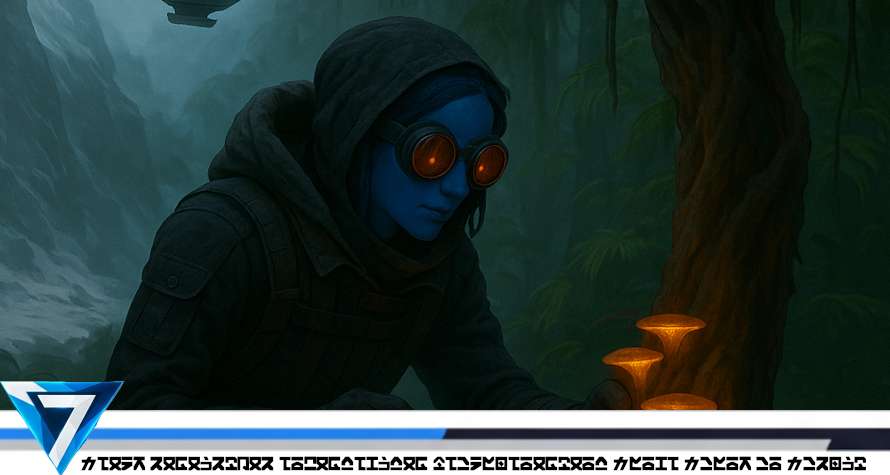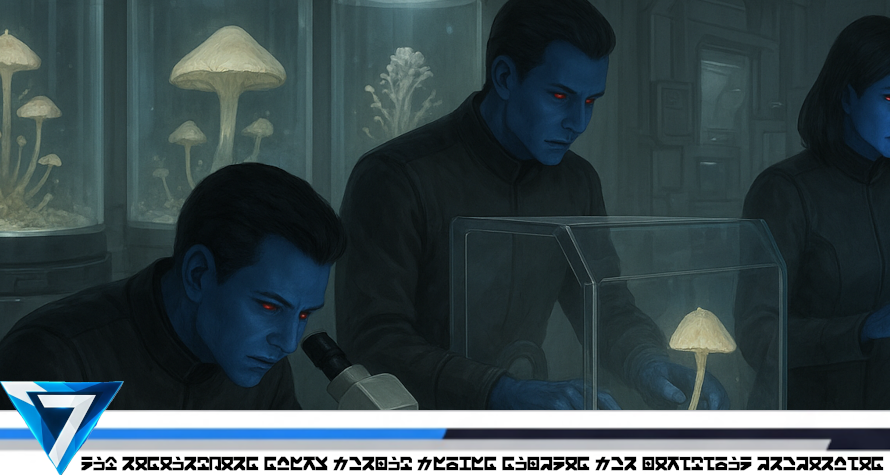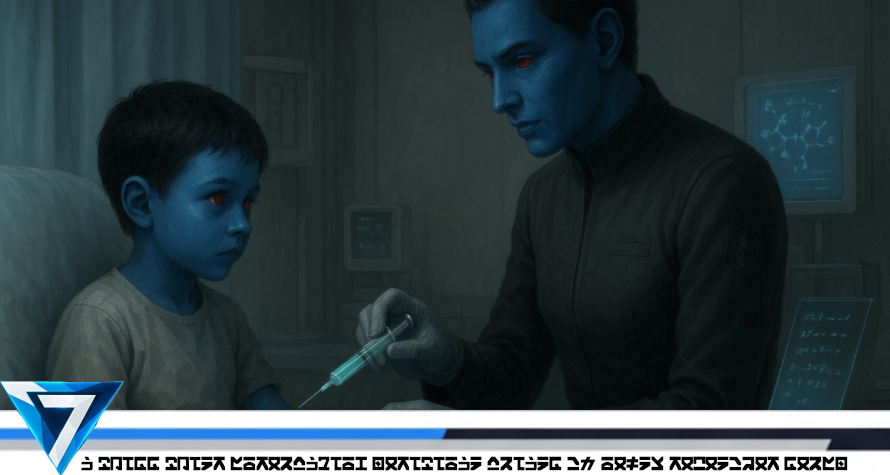From Ash to Immunity: How a Fungal Discovery is Protecting the Ascendancy’s Young
In the jagged basalt ridges of Formac’s volcanic ranges, teams of Chiss field researchers have been braving treacherous heat vents, unstable slopes, and ash-choked air to study an unusual fungal flora thriving in the region. These resilient organisms—some glowing faintly with bioluminescent caps, others forming thick mats of obsidian-black mycelium—draw nutrients from mineral-rich volcanic ash and withstand environmental extremes that would kill most lifeforms.
Lead field biologist Dr. Thryss’ali’nor described the find as “a living archive of chemical adaptations,” noting that the fungi’s resilience hinted at unique biological properties. Many equipped with thermal suits and atmospheric filtration gear, the research teams collected spore samples, preserving their intricate structure for further analysis on Csilla.

A Field Researcher investigates bioluminescent flora found on Formac…
Once delivered to House Chatkir’s Bio-Chemical Research Division, the samples underwent rigorous genomic and biochemical analysis, with teams of researchers cataloging and isolating each compound for detailed study. The results were striking: several species produced rare bioactive molecules with strong antiviral properties, far more potent than anything currently synthesized within Ascendancy laboratories. These compounds demonstrated a particular efficacy against respiratory pathogens, a persistent threat within Ascendancy space due to the cold and often enclosed environments of its core worlds. “One compound in particular appears to block viral replication at the cellular level,” explained Dr. Sevric’ath’oren, the senior scientist overseeing the laboratory trials. “If further development holds true, it could form the basis for an entirely new class of immunization agents, far beyond the limitations of current vaccines.” Preliminary testing not only confirmed remarkable efficacy against the Thryg-3 influenza strain—a seasonal illness notorious for sweeping through Csilla’s schools, academies, and even military fleets during the long cold cycle—but also suggested broader applications against related viral families. With such promising results, the discovery was quickly classified as a matter of strategic interest, with House Chatkir coordinating closely Formac’s infrastructure to secure further cultivation and refinement of the fungi before distribution trials could begin.

Lab Researchers study fungal Formac fungus samples for medicinal properties…
Within just a few months, the research advanced from controlled laboratory experiments to widespread clinical application. At the Nollaig Memorial Medical Complex—one of Csilla’s most prestigious centers of care—and at affiliated facilities across Ascendancy space, physicians began the first rounds of pediatric inoculations using a vaccine derived from the Formac fungal compounds. The serum, painstakingly refined into a stable and reliable formulation, was designed not only for safety but also for durability, ensuring that immunity could last through multiple seasonal cycles. Early trials focused on young children, who had historically been the most vulnerable to Thryg-3 outbreaks, and the results were nothing short of transformative. “The results have been extraordinary,” reported Chief Pediatrician Dr. Tirn’ova’sael, who supervised the initial clinical rollout. “Immunity rates are well above projections, with protection sustained far longer than any previous vaccine, and no serious side effects have been recorded.” As word of its success spread, the Department of Health authorized expanded distribution, making the vaccine a standard requirement for all children entering public education and military preparatory academies. Within a single cycle, the seasonal waves of Thryg-3—once a near inevitability during the cold months—had been drastically reduced, marking what many within the Ascendancy’s medical community called a historic turning point in public health.

A child undergoes medicinal trials of newly developed serum…
Parents across the Ascendancy have embraced the breakthrough with gratitude and relief, many describing a sense of security unknown in previous cold cycles. The prospect of ending the yearly waves of illness that once disrupted schools, academies, and even fleet operations has brought renewed confidence in both medical science and the institutions that delivered it. From the windswept volcanic ridges where the fungal samples were first collected, to the sterile, gleaming halls of Csilla’s central hospitals, the journey from ash to immunity has come to symbolize more than a scientific achievement—it is being celebrated as a triumph of perseverance, cooperation, and the Chiss capacity to draw strength from even the most inhospitable worlds. Commentators within both the scientific community and the Syndicure have already called it one of the Ascendancy’s most significant medical advancements in decades, a reminder that innovation often emerges from the unlikeliest of places. For many families, it stands as proof that the vast and often perilous reaches of Ascendancy space still hold the seeds of salvation, waiting only to be uncovered and refined for the greater good.







